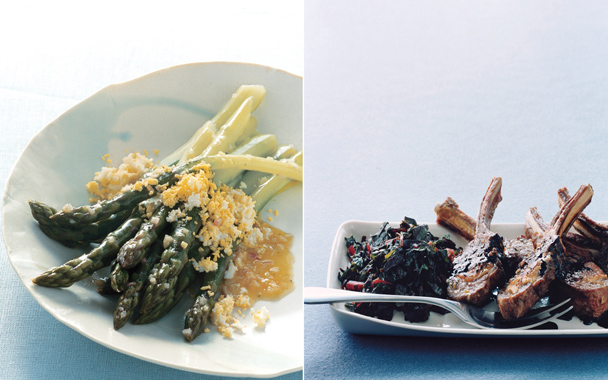A few months back, my fellow Gourmet food stylist Paul Grimes was at a photo shoot, plating an asparagus recipe. The photographer, Romulo Yanes, looking for the shot, rotated the plate until the tips of the asparagus were pointing towards the camera. The resulting photo was lovely, but Paul was appalled: Apparently Romulo’s move was a major vegetal sin. To some—I didn’t know exactly whom—asparagus must always point away. Gauche, rude, an assault on the diner? I had no idea. Did I go to culinary school on the wrong side of the tracks? How many plating felonies had I unwittingly committed?
I decided I needed to learn the rules (if there were any), so I started by calling someone whose job is to know them: As a CIA professor of culinary arts, John DeShetler has been shaping young chefs for the last 25 years. According to DeShetler, there aren’t necessarily rules so much as there are “professional guidelines” (which, quite frankly, sound a lot like rules when expressed with his zeal). Some rules—er, guidelines—include plating the carbs first, because they stay hot longest. The sauce goes under the meat if the meat is sautéed, grilled, or roasted. But if the meat is cooked in a wet method like braising, it gets sauced on top. I thought about all the times I had styled food in the pages of Gourmet and didn’t color between these lines. I don’t like sauce under meat because it looks like chicken in a puddle—it makes me think of a crime scene rather than supper. And besides, having sauce on top of food feels homey and immediate, like someone just passed you the gravy.
I haven’t always been a plating rebel, though. As a restaurant cook I simply plated food per the chef’s instruction and never questioned it. Later, when I was assisting food stylists, I did learn two plating commandments: First, food should be respected. I spoke with half a dozen chefs who echoed this sentiment. In the words of chef Alfred Portale, a former jewelry designer whose plating prowess is legendary: “Never compromise the integrity of the food for presentation.” The second commandment is more controversial: Keep odd numbers of ingredients on a plate. Portale agrees that odd numbers feel less static, but chef Michel Richard, more of a romantic, prefers even numbers to avoid couples squabbling over the last scallop—and subsequently fighting in bed. Then I talked with chef Jonathan Waxman, who suggested the unthinkable: Odd or even, it’s random. “Last night I served asparagus to my wife. We didn’t count them. I gave her enough. The plate looked beautiful.”
Of course, these chefs and I never would have been having this discussion 40 years ago—the concept of plating as we know it today didn’t even exist back then. Richard remembers how, when he was first starting out, food always left the kitchen on trays; the maitre’d carved, assembled, and sauced plates in the dining room. But in the early ’70s, with the advent of nouvelle cuisine, restaurant food changed radically. Chefs took over the assembling of plates, and soon there were specific styles and trends in plating just as there are in any art form. As chef Jean-Georges Vongerichten recalls, “in the ’70s it was ‘protein forward,’” with the meat at the front of the plate. “The ’80s were the decade of ‘on a bed of,’ with everything on top like a skyscraper. The ’90s brought deconstructed plates; and now it’s technology—you don’t even know if it’s a real egg.” Vongerichten, for his part, is drawing on inspiration from the past, having servers plate certain elements of the dish at the table; it enhances what he calls the “woo-oooh-aah, the wow factor.” Thinking about plating trends in this way made me realize just how subjective the rules (or “guidelines”) really are.
And those asparagus tips? There’s no simple answer there, either. Waxman, who got his culinary education in the ’70s, recalls the “asparagus holder,” a cradle-like contraption not unlike a toast holder; properly served asparagus were laid on the holder with their tips pointing to the right. But in the late ’70s or early ’80s, Waxman says, asparagus began to be arranged in rings on the plate, tips pointing outward. That probably defines the end of civilization as we know it, leading to wanton asparagus placement that Waxman describes as “out of the box, into the fire, and onto the plate.” Currently, Waxman likes his asparagus “deconstructed to the nth degree,” but if pressed, he’d have them all pointing to the right. At Richard’s Citronelle, on the other hand, asparagus are plated in a glass, pointy side down, and are to be eaten with your fingers. Shocking, perhaps—but at least they’re not pointing at you accusingly as you flaunt your bad table manners.




 Pinterest
Pinterest


